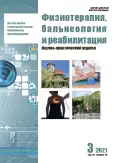Analgesia by laserophoresis of herbal extracts in treatment of patients with lumbosacral dorsopathy
- Authors: Korchazhkina N.B.1, Kupeev R.V.2
-
Affiliations:
- Russian Scientific Center of Surgery named after Academician B.V. Petrovsky
- Central State Medical Academy of Department of Presidential Affairs
- Issue: Vol 20, No 3 (2021)
- Pages: 193-198
- Section: Original studies
- URL: https://journals.rcsi.science/1681-3456/article/view/106150
- DOI: https://doi.org/10.17816/1681-3456-2021-20-193-198
- ID: 106150
Cite item
Abstract
BACKGROUND: The article describes the pharmaco-physiotherapeutic method of analgesia for pain in the lumbosacral spine. The possibilities of introducing the method of transcutaneous analgesia into therapy using laserophoresis of a biological complex of water extracts of field horsetail and St. John's wort are shown. These phytoextracts were used in the laser phoresis method due to the fact that they have analgesic, decongestant and adaptogenic effects, as well as reduce the metabolic activity of chemical agents, including inflammatory ones.
AIMS: Study of the analgesic effect of the developed method of phytocomplex laserphoresis in comparison with the standard scheme of nonsteroidal anti-inflammatory drugs.
MATERIAL AND METHODS: The study included 48 patients with a confirmed diagnosis of lumbosacral dorsopathy accompanied by pain syndrome were under observation. The main group consisted of 28 people who underwent phytocomplex laserphoresis procedures as a local treatment. The control group consisted of 20 people, where the standard treatment with NSAID drugs was prescribed. The study included observation and control before and after the course of treatment conducted in a polyclinic. To assess the severity of pain was applied to the visual analogue pain scale and the method of tensoalgometry.
RESULTS: All patients underwent treatment well, there were no cases of interruption of the course of treatment. As a result of dynamic analysis of indicators performed before and after treatment, pain scale and tenzoalgometry indicators showed results indicating faster and more effective relief of pain in patients of the main study group. When summing up the results of treatment, the improvement in pain scale indicator showed an 83% improvement in the main group (p <0.05), while the improvement in the control group was only 39%. According to the control tensoalgometry, in the main group, pain thresholds improved by 32% (p <0.05), while in the control group the improvement was only 12%.
CONCLUSION: The resulting analgesic effect is formed due to the anti-inflammatory effect of low-intensity laser radiation, as well as the therapeutic properties of the phytocomplex used, which can replace the use of NSAIDs for analgesia of pain in the lumbosacral region.
Keywords
Full Text
##article.viewOnOriginalSite##About the authors
Natalia B. Korchazhkina
Russian Scientific Center of Surgery named after Academician B.V. Petrovsky
Author for correspondence.
Email: n9857678103@gmail.com
ORCID iD: 0000-0001-6913-8778
SPIN-code: 9733-7646
MD, Dr. Sci. (Med.), Professor
Russian Federation, MoscowRuslan V. Kupeev
Central State Medical Academy of Department of Presidential Affairs
Email: n9857678103@gmail.com
ORCID iD: 0000-0002-7927-3508
SPIN-code: 7204-6363
Russian Federation, Moscow
References
- Makina SK, Agasarov LG. Optimization of complex therapy of dorsopathy patients. Traditional Medicine. 2012;(3):13–15. (In Russ).
- Golubenko EO, Silina EV, Orlova AS. Personalized medicine in pain management. Modern Science: Actual Problems Theory Practice (Natural and Technical Sciences). 2017;(7-8):107–112. (In Russ).
- Khadartsev AA, Kupeev VG, Moskvin SV. Fitolazeroforez. Moscow; Tver: Triada; 2016. 96 р. (In Russ).
- Moskvin SV, Minenkov AA. Mechanisms of laserophoresis with biologically active substances applied in medicine and cosmetology. Laser Medicine. 2012;16(4):41–44. (In Russ.)
- Sazonov AS, Khadartsev AA, Belyaeva EA. Devices for experimental research of laser- and electroiono phoresis. Bulletin of New Medical Technologies. 2016;23(2):178–181. (In Russ). doi: 10.12737/20445
- Vashchenko AA. Phytotherapy of the musculoskeletal system (horsetail, St. John's wort, bird highlander, hanging birch). Bulletin of Medical Internet Conferences. 2014;4(12):1408. (In Russ).
- Belyaeva EA. Aspects of Restorative medicine of DDD. Bulletin of New Medical Technologies. 2011;18(1):28–31. (In Russ).
- Khadartsev AA, Fudin NA, Moskvin SV. The electrolaser myostimulation and laserophoresis of biologically active compounds in sports medicine (a review). Problems Balneology, Physiotherapy, Exercise Therapy. 2016;93(2):59–67. (In Russ). doi: 10.17116/kurort2016259-67
- Boytsov IV. Patients with dorsopathies: analysis of the effectiveness of therapy. General Practitioner's Handbook. 2013;(4):27–35. (In Russ).
- Boytsov IV. Pathogenesis of dorsopathies: violation of microcirculation in the tissues of the vertebral-motor segments (literature review). General Practitioner's Handbook. 2013;(3):69–72. (In Russ).
Supplementary files







